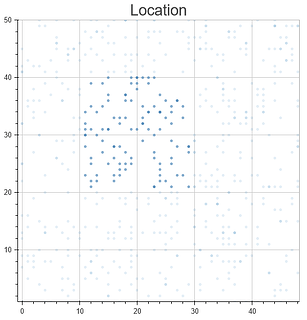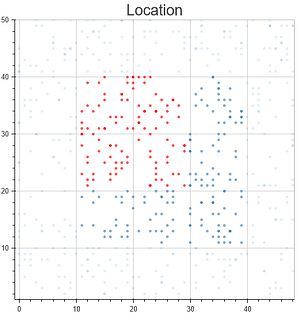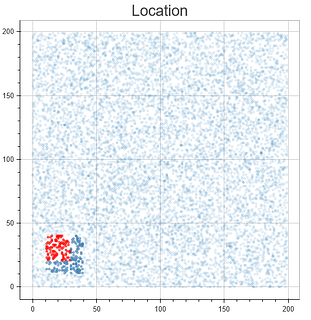On Jan 24, 2016, at 4:07 PM, wcopeland <[email protected]> wrote:
Thank you all for the very fast responses!
I have tried all of the suggested ways, but it still does not work properly. The code for the refresh function is now:
updated_color_list = ['steelblue'] * len(self.graph_plot.data_source.data['color'])
for idx in new_idxs:
updated_color_list[idx] = 'red'
self.graph_source.data.update({'color': updated_color_list})
self.graph_source.trigger('data', self.graph_source.data, self.graph_source.data)
Interestingly, this works, but on a "selection delay". It almost seems as if the default selection behavior is overriding my changes. I have added a set of pictures that can explain what I mean.
Figure 1. I zoom in on the coordinates between (0,0) and (50,50).
Figure 2. I select coordinates between (10,20) and (30,40). I would expect all those coordinates to turn RED, but all remain BLUE.
Figure 3. I select coordinates between (10,10) and (40,40). I would expect all those coordinate to turn RED. The points from the previous selection - those between (10,20) and (30,40) - turn RED. The additional coordinates are BLUE.
Figure 4. I reset the zoom to its original scope and see that
<Auto Generated Inline Image 1.png><Auto Generated Inline Image 2.png><Auto Generated Inline Image 3.png><Auto Generated Inline Image 4.png>
On Saturday, January 23, 2016 at 5:52:00 PM UTC-8, wcopeland wrote:Hi, I recently was introduced to Bokeh and love its potential! I work at a pharma company and have set out to create a bokeh server app for data visualization. I have had a hard time efficiently refreshing plots in the client-side browser. I coded a smaller app that replicates the issue I am having. The app produces a scatter plot using (x,y) coordinates from a data frame. I want to add interactions such that when a user either (1) selects points on the plot or (2) enters the name of comma-separated points in the text box (ie. "p55, p1234"), then those points will turn red on the scatter plot.
I had pasted the code here: bokeh_help - Pastebin.com
The code that updates the graph can be found in the function refresh_graph().
I have found that if I drill into the ColumnDataSource and change only a few values, they do not get updated in the graph on client-browser (Strategy 1). The only way I can seem to make the client-browser update is if I completely reassign the value to the plot's figure (Strategy 3). However, even though Strategy #3 works, it takes a relatively long time (~500ms vs ~1ms).
Thanks for your help!
On Sunday, January 24, 2016 at 12:03:04 PM UTC-8, Havoc Pennington wrote:
It should, yes:
https://github.com/bokeh/bokeh/blob/master/bokeh/core/property_containers.py#L159
(the dict will be wrapped in that dict proxy class so we see changes)
Havoc
On Jan 24, 2016, at 11:40 AM, Ben Cipollini <[email protected]> wrote:
Havoc,
Would dict.update({'x': array1, 'y': array2}) trigger a single remote update, and avoid having to rebuild a new dict?
Ben
On Sun, Jan 24, 2016 at 8:37 AM, Havoc Pennington <[email protected]> wrote:
Hi,
0.11 is not very smart about updating data - all updates are on the attribute level, which means the change notification is for ColumnDataSource's data attribute, and if anything changes we send the entire `data` again.
In the short term, the most important thing to do is probably to update everything you plan to change about `data` and only then set the new `data`, so the change notification happens once. If you write code like this, there are two notifications:
source.data['x'] = array1 # notifies by resending entire data
source.data['y'] = array2 # notifies again resending entire data again
This is both inefficient and looks ugly (two visible updates to the plot). Better is to first make a whole new dict and then:
source.data = new_data # notify one time
We intercept changes to the dict (setting a whole new column) but we don't wrap the individual data arrays so if you modify them "underneath" the data source, we don't know about the changes I guess. It is possible to do a `source.trigger('data', source.data, source.data)` which should cause things to be sent on the wire by forcing a change notification. Making this work magically might create an unfortunate performance penalty... it may not make sense.
Two PRs that would be great to have in the future:
* support partial updates to dictionaries and lists. We track changes to dicts and lists via https://github.com/bokeh/bokeh/blob/3e2a9737d510abede1be090e4ee9fa6dcab037aa/bokeh/core/property_containers.py and the information that we've appended some elements or modified a single element in-place could be communicated through _notify_owners into properties.py and ultimately result in extra information attached to the ModelChangedEvent emitted by Document. Then the websocket protocol could send a message with only the new or changed elements.
* support binary encoding; rather than inserting the array into the JSON, insert a marker in the JSON that says "byte array <ID> will follow which has type <datatype>", then append to the websocket message said byte array. This should only happen when the JSON is websocket-bound and not when it's going to a file or elsewhere, so it's probably an optional feature of Model.to_json and Document.to_json.
Those two changes should be a nice performance boost in many situations, though of course there are limits (no matter what we do, if a callback changes lots of values in a really large data array, we'll be shoveling a lot of data over the socket). But optimizing append or single-dict patches should be helpful for things like a streaming data source, and binary encoding should be a nice constant-factor improvement in performance.
Havoc
On Sat, Jan 23, 2016 at 8:51 PM, wcopeland <[email protected]> wrote:
Hi, I recently was introduced to Bokeh and love its potential! I work at a pharma company and have set out to create a bokeh server app for data visualization. I have had a hard time efficiently refreshing plots in the client-side browser. I coded a smaller app that replicates the issue I am having. The app produces a scatter plot using (x,y) coordinates from a data frame. I want to add interactions such that when a user either (1) selects points on the plot or (2) enters the name of comma-separated points in the text box (ie. "p55, p1234"), then those points will turn red on the scatter plot.
I had pasted the code here: bokeh_help - Pastebin.com
The code that updates the graph can be found in the function refresh_graph().
I have found that if I drill into the ColumnDataSource and change only a few values, they do not get updated in the graph on client-browser (Strategy 1). The only way I can seem to make the client-browser update is if I completely reassign the value to the plot's figure (Strategy 3). However, even though Strategy #3 works, it takes a relatively long time (~500ms vs ~1ms).
Thanks for your help!
--
You received this message because you are subscribed to the Google Groups "Bokeh Discussion - Public" group.
To unsubscribe from this group and stop receiving emails from it, send an email to bokeh+un...@continuum.io.
To post to this group, send email to bo...@continuum.io.
To view this discussion on the web visit https://groups.google.com/a/continuum.io/d/msgid/bokeh/5b2120dc-242d-4f96-b9ec-2f18a3b1250a%40continuum.io\.
For more options, visit https://groups.google.com/a/continuum.io/d/optout\.
--
Havoc Pennington
Senior Software Architect
--
You received this message because you are subscribed to the Google Groups "Bokeh Discussion - Public" group.
To unsubscribe from this group and stop receiving emails from it, send an email to bokeh+un...@continuum.io.
To post to this group, send email to bo...@continuum.io.
To view this discussion on the web visit https://groups.google.com/a/continuum.io/d/msgid/bokeh/CAC%2B_nE0sgAK-rKcsf27O3wA8gQe4SF8m%2BY4Ns%3D2fg0oPQ1avbw%40mail.gmail.com\.
For more options, visit https://groups.google.com/a/continuum.io/d/optout\.
--
You received this message because you are subscribed to the Google Groups "Bokeh Discussion - Public" group.
To unsubscribe from this group and stop receiving emails from it, send an email to bokeh+un...@continuum.io.
To post to this group, send email to bo...@continuum.io.
To view this discussion on the web visit https://groups.google.com/a/continuum.io/d/msgid/bokeh/CANgTvZgxK7xv6myVdX6BjyH%2B3mRhPqaGT5bbsrMcOh-PpiUcDg%40mail.gmail.com\.
For more options, visit https://groups.google.com/a/continuum.io/d/optout\.
--
You received this message because you are subscribed to the Google Groups "Bokeh Discussion - Public" group.
To unsubscribe from this group and stop receiving emails from it, send an email to [email protected].
To post to this group, send email to [email protected].
To view this discussion on the web visit https://groups.google.com/a/continuum.io/d/msgid/bokeh/51684a81-370f-4b86-8a6f-0e19a7de6c29%40continuum.io\.
For more options, visit https://groups.google.com/a/continuum.io/d/optout\.
<Auto Generated Inline Image 1.png><Auto Generated Inline Image 2.png><Auto Generated Inline Image 3.png><Auto Generated Inline Image 4.png>



